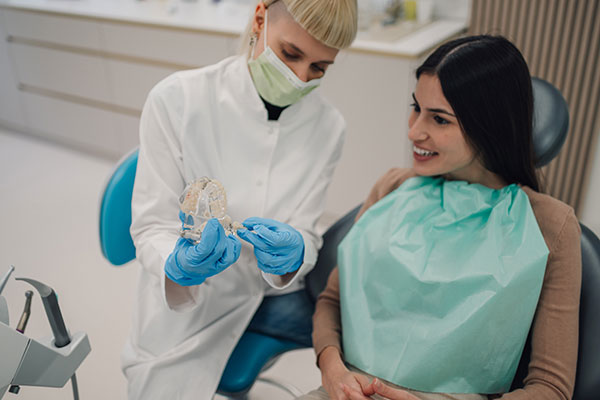Gum Recession and Receding Gums

Gum recession is a dental condition that occurs when a person’s gums recede from a tooth, exposing its root. According to the Mayo Clinic, there are over 200,000 cases of receding gums in the United States each year.
Receding gums are a significant dental health concern because they create space between the teeth and the gums. This leaves the teeth where the gums have receded vulnerable to harmful bacteria. These bacteria can cause tooth decay, infections or in some cases, tooth loss.
What causes gum recession?
When it comes to serious oral health issues like gum recession, prevention is essential. People who want to make sure their teeth and gums are as healthy as possible should note the causes of gum recession in order to take steps to avoid this condition.
Here are the main causes of receding gums:
Inadequate oral hygiene
One of the leading causes of receding gums is gum disease, which is often a result of subpar oral hygiene. People who do not brush or floss their teeth regularly or schedule visits to the dentist to remove harmful plaque and tartar build-up are especially prone to gum recession.
The best way for individuals to lower their risk of gum recession is to brush their teeth, floss and use an antiseptic mouthwash every day. It is also important to schedule regular dentist appointments so dentists can remove calculus from the mouth and monitor gum health.
Genetic factors
Some individuals have a higher likelihood of developing gum recession because of the way their teeth are positioned in their mouth, the size of their gums or other genetic factors outside of their control.
People who have a predisposition to gum recession should make sure to visit their dentist frequently to monitor the health of their gums. This way, if any signs of gum recession are detected, the dentist can prevent the problem from escalating further.
Gum wear
While vigilant brushers may think that they are doing their part to reduce their risk of developing receding gums, they may be causing more harm than good. Overbrushing or brushing teeth using too much force increases the wear and tear of the gums. This can increase the chances of a person developing gaps between their teeth and gums.
Options for preventing gum recession from this physical wear are to avoid sugary drinks that tear down the enamel of a tooth, use toothbrushes with soft or medium bristles and brush teeth using a non-aggressive technique.
Treating gum recession
Sometimes people do not realize that their gums have receded until they are experiencing sensitivity and pain from infection or tooth decay. In these cases where it is too late to prevent gum recession, there are treatment options available.
People who suspect that they are experiencing gum recession should talk to their dentist about minimally invasive gum recession treatments. These treatment options can help prevent further damage and reduce teeth and gum sensitivity.
Let's get started
Request an appointment here: https://thechesterfielddentist.com or call Chesterfield Dentist at (804) 412-0867 for an appointment in our Chester office.
Check out what others are saying about our services on Yelp: Read our Yelp reviews.
Recent Posts
As a child’s mouth and teeth develop into adolescence, it may become apparent that there are problems with alignment or spacing. Invisalign® for teens presents an alternative to traditional metal braces but without sacrificing the quality of results of corrective treatment. The specifics of a teen’s condition may impact the eligibility of this alignment option,…
Gum disease is a common yet serious oral health issue that can cause discomfort, damage, and even tooth loss if left untreated. With the right gum disease treatment, patients can not only stop the infection in its tracks but also restore the patient's overall oral health. Knowing the true impact of gum disease and how…
A popular way to straighten teeth without traditional braces is Invisalign®. Clear aligners are available for both adults and teenagers who are interested in improving the alignment of their teeth and improving the appearance of their smiles. The aligners are not visible in the mouth and do not have metal components that can irritate sensitive…
If you are a teenager whose dentist recommends Invisalign to straighten your teeth, you may wonder what the product is. Many dentists advise Invisalign® for teens as a discreet and reliable method of treating crooked teeth. However, you may only be familiar with traditional braces. Invisalign is a different way to fix malocclusions or imperfect…


